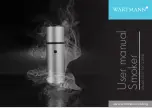
1 / 4
AirSD-100S
02-64/2019 Rev.: 0
1
1
1
8
4
4
4
4
7
2
2
2
2
6
5
3
3
3
1
2
+
-
+
-
+
-
+
-
5
4
a)
b)
3
ON
1 2 3
+
-
-
+
-
+
-
ELKO EP, s.r.o.
Palackého 493
769 01 Holešov, Všetuly
Czech Republic
Tel.: +420 573 514 211
e-mail: [email protected]
www.elkoep.com
EN
Made in Czech Republic
Characteristics General
instrucions
• The smoke detector is used for the early warning of an emerging fi re in residential
and commercial buildings and also measures the actual temperature, humidity
and light intensity in the room.
• The detector utilises a scanning method using an optical chamber, which has en-
hanced smoke detection responses.
• Self-test function highlights the failure of the detector, eliminating the malfunc-
tion in the event of a fi re.
• Anti-sabotage: If access to the device is unauthorized, a message is immediately
sent to the server.
• Thanks to the wireless solution and Sigfox communication, it can communicate
instantly to your chosen location and be operated immediately.
• Data is sent to the server from which it can be subsequently displayed as a smart-
phone, application, or Cloud notifi cation.
• Battery power can be sent to the server when it is powered by a battery.
• Power supply: battery 4 x 1.5 V AA, the battery life is around 1 year.
Description
1. Two-color LED position
2. Holes for locking segments
3. Battery
4. Secure segments
5. DIP switch - Position 1 - Turn off
scanning signaling
6. Button SET
7. Tamper position
8. Probe for magnet scanning
tampermenty
The underside of
the detector
The inner side of
the base
The front of the
detector
Cloud app assignment
It is done in your Smartphone application. Enter the relevant data located on the detec-
tor cover into the application.
Smoke detector
Assembly
1. Place the base at the desired location (on a fl at surface). You can use the base as a drilling
template. Attach the base with suitable bonding material * according to the substrate.
2. Insert the batteries into the detector and check that they are correctly positioned (a
detector functionality message will be sent to the application when the batteries are
inserted).
3. Set DIP 1 as required.
4. Attach the detector to the base so that the projection on the base faces the tamper posi-
tion in the detector cover (a). Turn the detector clockwise (b).
5. Press the test button to test the correct alarm function (see Test Detector Test).
* Suitable fi tting material can be, for example, a countersunk head screw, a screw Ø of
3 mm.
Internet of Things (IoT)
• The IOT wireless communications category describes the Low Power Wide Area
(LPWA). This technology is designed to provide full-range coverage both inside and
outside buildings, energy-saving and low-cost operation of individual devices. The
Sigfox network is available to use this standard.
Sigfox network information
• The network supports bidirectional communication but with a limited number of feed-
backs. It uses the free frequency band divided by Radio Frequency Zones (RCZ).
• RCZ1 (868 MHz) Europe, Oman, South Africa
• RCZ2 (902 MHz) North America
• RCZ3 (923 MHz) Japan
• RCZ4 (920 MHz) South America, Australia, New Zealand, Singapore, Taiwan
• Sigfox has more coverage across countries, so it is better suited for long distance mo-
nitoring.
• For more information on this technology, please visit www.sigfox.com.
Caution for proper operation:
• Products are installed according to the wiring diagram given for each product.
• For proper device functionality, it is necessary to have suffi
cient coverage of the selec-
ted network at the installation site.
• At the same time, the device must be registered in the network. Successful device re-
gistration on a given network requires a charge for traffi
c.
• Each network off ers diff erent tariff options - it always depends on the number of me-
ssages you want to send from your device. Information on these tariff s can be found in
the current version of the ELKO EP pricelist.





















